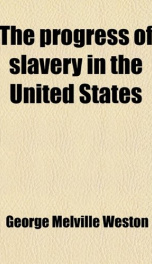the progress of slavery in the united states

Purchase of this book includes free trial access to www.million-books.com where you can read more than a million books for free. This is an OCR edition with typos. Excerpt from book: The problem in respect to Missouri was, and is, what institutions shall be dominant in a region, whose institutions are not yet definitely fixed. The problem in respect to Maryland and Virginia is, by what processes, through what efforts and sacrifices, and in the lapse of what period, States gangrened to the vitals by a fatal mischief, can be restored to health and soundness. Happy for them, if they do not present a new verification of the truth, that while diseases may be quick, remedies must be slow. CHAPTER HI. Considerations rendering it probable that the emigration from the free States, hitherto moving westward, may hereafter tend southward, to Maryland, Virginia, and Kentucky. Accumulated power of the population of the free States. No apology for slavery in the northern slave States. The right of emigration between the States. In the interval between 1790 and 1850, the slaves in the slave States increased five-fold; from 657,533 to 3,200,364. In the same interval, the whites in the free States increased seven-fold; from 1,900,976 to 13,330,650, and outnumbered the slaves more than four to one, instead of only three to one, as in 1790. The ratio of the increase of the slaves is a declining one, while that of the free States is steady, and may be an augmenting one. It is most clear, that free labor is accumulating an enormous power, for whatever point and whatever moment the two opposing forces may come into collision. That moment has not yet arrived, and may yet bo longer postponed. The territorial acquisitions of thefree States towards the "West have been ample for the expansion and development of their population, which has not yet been forced by compression to seek an outlet to the southward. The territorial acquisitions of the slave States have been remote, a...
Info about the book
Author:
Series:
Unknown
ISBN:
1108020003
Rating:
5/5 (1)Your rating:
0/5
Languge:
English
Users who have this book
Users who want this book
What readers are saying
What do you think? Write your own comment on this book!
write a commentGenre
if you like the progress of slavery in the united states try:
Other books by this author
Do you want to read a book that interests you? It’s EASY!
Create an account and send a request for reading to other users on the Webpage of the book!


